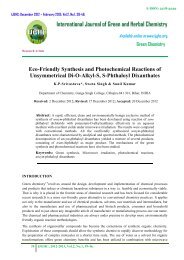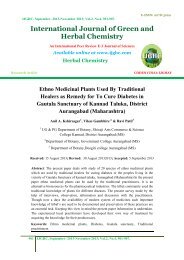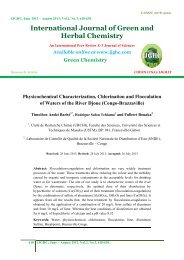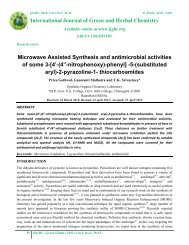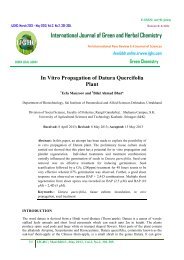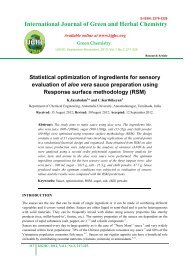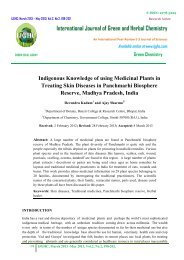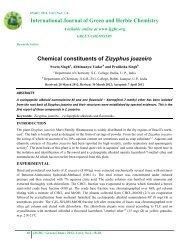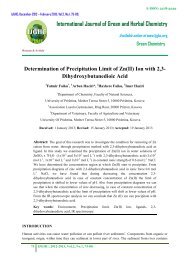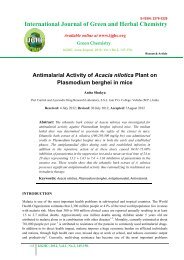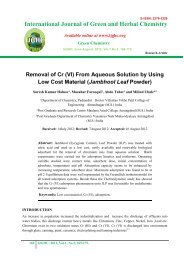Emofuel to Save Earth - IJGHC
Emofuel to Save Earth - IJGHC
Emofuel to Save Earth - IJGHC
Create successful ePaper yourself
Turn your PDF publications into a flip-book with our unique Google optimized e-Paper software.
<strong>IJGHC</strong>, June 2013 – August 2013; Vol.2, No.3; 692-702.<br />
International Journal of Green and<br />
Herbal Chemistry<br />
An International Peer Review E-3 Journal of Sciences<br />
Available online at www.ijghc.com<br />
Green Chemistry<br />
E-ISSN: 2278-3229<br />
Research Article<br />
CODEN (USA): IJGHAY<br />
<strong>Emofuel</strong> <strong>to</strong> <strong>Save</strong> <strong>Earth</strong><br />
J.S. Waghmare, Asma D. Fakir, Sadanand S. Kadam<br />
Oils, Oleochemicals and Surfactant technology, Institute<br />
of chemical technology, Mumbai, Maharashtra, India.<br />
Received: 6 June 2013; Revised: 16 August 2012; Accepted: 24 August 2013<br />
Abstract: Diesel engines are widely used as the driving power for both in-lands as well as<br />
marine transportation vehicles. It is because of Diesel engines has rigid structure, low<br />
breakdown rate, high thermal efficiency and high fuel economy. Because of these<br />
advantages of diesel engines, it is expected that diesel engines will be widely used in the<br />
upcoming future. However, nitrogen oxide and particulate matter these are the pollutants,<br />
which are emitted from diesel, and they are harmful <strong>to</strong> the health of living beings and<br />
environment. Therefore, diesel has been recognized as the major air pollution source in<br />
metropolitan areas. Because of this problem occurs by using diesel as engine fuel thus<br />
attracted much research interest. In the recent several years, the technology of application of<br />
emulsion fuels <strong>to</strong> many boilers, furnaces and diesel engines has attracted much attention<br />
from the point of view of the energy saving and of the prevention of atmospheric pollution.<br />
It is, mainly due <strong>to</strong> the recent high cost of crude oil. Emulsion fuel is a blend of existing fuel<br />
oil (heavy oil, light oil, kerosene etc) mixed with about 10-30% water. It is a new type of<br />
fuel used in internal combustion chambers such as engines; boilers etc and can reduce fuel<br />
consumption and emissions like NOx, PM and smoke by improving fuel efficiency. Many<br />
studies on emulsion fuels reveal that they have various benefits, including improvement in<br />
combustion efficiency and a reduction in particulate matter (PM) and nitrogen oxide (NOx)<br />
emissions. This review article provides information of emulsion, emulsion types, stability<br />
problems and emulsion fuel mechanism.<br />
Keywords: microemulsions, nanoemulsions, Lipophilic, micronization.<br />
692 <strong>IJGHC</strong>; June – August 2013, Vol.2, No.3, 692-702.
<strong>Emofuel</strong>...<br />
J.S. Waghmare et al.<br />
INTRODUCTION<br />
In the recent several years, as same as in over about thirty years ago, the technology of application of<br />
emulsion fuels <strong>to</strong> many boilers, furnaces and diesel engines has attracted much attention from the<br />
point of view of the energy saving and of the prevention of atmospheric pollution caused by the<br />
exhaust from many combustion facilities. It is, mainly, due <strong>to</strong> the recent high cost of crude oil and <strong>to</strong><br />
the prevalence of the national consensus of the protection of environment.<br />
Will emulsion fuels save the <strong>Earth</strong> Emulsion fuel technology remains immature and falls short of<br />
providing a definitive solution <strong>to</strong> the question. Despite the great advances in the scientific and<br />
technological research of the technology, many different questions remain unsolved. Emulsion fuels<br />
refer <strong>to</strong> the emulsified mixture of petroleum-based fossil fuels, including gasoline, light oil, heavy oil,<br />
kerosene and waste oil, and water. A mechanism is assumed <strong>to</strong> work in emulsion fuels, which<br />
improves the combustion efficiency of the emulsified fossil fuel by virtue of the emulsified water. To<br />
provide this mechanism, various production devices have been proposed, although there has been no<br />
single technology developed <strong>to</strong> a satisfac<strong>to</strong>ry level. More recently, an innovative emulsion fuel<br />
production technology has been available that solves several problems inherent <strong>to</strong> this kind of fuel.<br />
Emulsion fuel is a blend of existing fuel oil (heavy oil, light oil, kerosene etc) mixed with about 10-<br />
30% water. It is a new type of fuel used in internal combustion chambers such as engines; boilers etc<br />
and can reduce fuel consumption and emissions like NOx, PM and smoke by improving fuel<br />
efficiency.<br />
It was first used in the US more than 40 years ago and many different types have been tested in Japan<br />
as well. Although it was commercialized as a new type of fuel about 10 years ago in the US and<br />
Europe with government support such as tax incentives and subsidies, currently its use has not been<br />
fully established yet.<br />
EMULSION<br />
An emulsion is a mixture of two or more liquids that are normally immiscible (nonmixable or<br />
unbendable). Emulsions are part of a more general class of two-phase systems of matter called<br />
colloids. Although the terms colloid and emulsion are sometimes used interchangeably, emulsion<br />
should be used when both the dispersed and the continuous phase are liquids. In an emulsion, one<br />
liquid (the dispersed phase) is dispersed in the other (the continuous phase). Examples of emulsions<br />
include vinaigrettes, milk, mayonnaise, and some cutting fluids for metal working. The pho<strong>to</strong>sensitive<br />
side of pho<strong>to</strong>graphic film is also an example of a colloid. The word "emulsion" comes from the Latin<br />
word for "<strong>to</strong> milk", as milk is (among other things) an emulsion of milk fat and water.<br />
Two liquids can form different types of emulsions. As an example, oil and water can form, firstly, an<br />
oil-in-water emulsion, where the oil is the dispersed phase, and water is the dispersion medium.<br />
Secondly, they can form a water-in-oil emulsion, where water is the dispersed phase and oil is the<br />
external phase. Multiple emulsions are also possible, including a "water-in-oil-in-water" emulsion and<br />
an "oil-in-water-in-oil" emulsion.<br />
Appearance and Properties: Emulsions contain both a dispersed and a continuous phase, with the<br />
boundary between the phases called the "interface". Emulsions tend <strong>to</strong> have a cloudy appearance<br />
because the many phase interfaces scatter light as it passes through the emulsion. Emulsions appear<br />
white when all light is scattered equally. If the emulsion is dilute enough, higher-frequency and lowwavelength<br />
light will be scattered more, and the emulsion will appear bluer - this is called the<br />
"Tyndall effect". If the emulsion is concentrated enough, the color will be dis<strong>to</strong>rted <strong>to</strong>ward<br />
693 <strong>IJGHC</strong>; June – August 2013, Vol.2, No.3, 692-702.
<strong>Emofuel</strong>...<br />
J.S. Waghmare et al.<br />
comparatively longer wavelengths, and will appear more yellow. This phenomenon is easily<br />
observable when comparing skimmed milk, which contains little fat, <strong>to</strong> cream, which contains a much<br />
higher concentration of milk fat.<br />
Two special classes of emulsions - microemulsions and nanoemulsions, with droplet sizes below<br />
100 nm - appear translucent. This property is due <strong>to</strong> the fact that light waves are scattered by the<br />
droplets only if their sizes exceed about one-quarter of the wavelength of the incident light. Since the<br />
visible spectrum of light is composed of wavelengths between 390 and 750 nanometres (nm), if the<br />
droplet sizes in the emulsion are below about 100 nm, the light can penetrate through the emulsion<br />
without being scattered.<br />
Due <strong>to</strong> their similarity in appearance, translucent nanoemulsions and microemulsions are frequently<br />
confused. Unlike translucent nanoemulsions, which require specialized equipment <strong>to</strong> be produced,<br />
microemulsions are spontaneously formed by “solubilising” oil molecules with a mixture of<br />
surfactants, co-surfactants, and co-solvents. The required surfactant concentration in a microemulsion<br />
is, however, several times higher than that in a translucent nanoemulsion, and significantly exceeds<br />
the concentration of the dispersed phase. Because of many undesirable side effects caused by<br />
surfactants, their presence is disadvantageous or prohibitive in many applications. In addition, the<br />
stability of a microemulsion is often easily compromised by dilution, by heating, or by changing pH<br />
levels.<br />
Common emulsions are inherently unstable and, thus, do not tend <strong>to</strong> form spontaneously. Energy<br />
input - through shaking, stirring, homogenizing, or exposure <strong>to</strong> power ultrasound - is needed <strong>to</strong> form<br />
an emulsion. Over time, emulsions tend <strong>to</strong> revert <strong>to</strong> the stable state of the phases comprising the<br />
emulsion. An example of this is seen in the separation of the oil and vinegar components of<br />
vinaigrette, an unstable emulsion that will quickly separate unless shaken almost continuously. There<br />
are important exceptions <strong>to</strong> this rule - microemulsions are thermodynamically stable, while<br />
translucent nanoemulsions are kinetically stable.<br />
Whether an emulsion of oil and water turns in<strong>to</strong> a "water-in-oil" emulsion or an "oil-in-water"<br />
emulsion depends on the volume fraction of both phases and the type of emulsifier (surfactant) (see<br />
Emulsifier, below) present. In general, the Bancroft rule applies. Emulsifiers and emulsifying particles<br />
tend <strong>to</strong> promote dispersion of the phase in which they do not dissolve very well. For example, proteins<br />
dissolve better in water than in oil, and so tend <strong>to</strong> form oil-in-water emulsions (that is, they promote<br />
the dispersion of oil droplets throughout a continuous phase of water).<br />
Instability: Emulsion stability refers <strong>to</strong> the ability of an emulsion <strong>to</strong> resist change in its properties<br />
over time 5 . There are three types of instability in emulsions: flocculation, creaming, and coalescence.<br />
Flocculation describes the process by which the dispersed phase comes out of suspension in the form<br />
of flakes. Coalescence is another form of instability - small droplets bump in<strong>to</strong> each other within the<br />
media volume and continuously combine <strong>to</strong> form progressively larger droplets. Emulsions can also<br />
undergo creaming, where one of the substances migrates <strong>to</strong> the <strong>to</strong>p (or the bot<strong>to</strong>m, depending on the<br />
relative densities of the two phases) of the emulsion under the influence of buoyancy, or under the<br />
influence of the centripetal force induced when a centrifuge is used.<br />
"Surface active substances" (or "surfactants") can increase the kinetic stability of emulsions so that the<br />
emulsion does not change significantly with time. A "non-ionic" surfactant solution can become selfcontained<br />
under the force of its own surface tension, remaining in the shape of its previous container<br />
for some time after the container is removed.<br />
694 <strong>IJGHC</strong>; June – August 2013, Vol.2, No.3, 692-702.
<strong>Emofuel</strong>...<br />
J.S. Waghmare et al.<br />
TYPES OF EMULSION<br />
There are mainly four types of emulsions. They are as follows:<br />
1. Simple Emulsion<br />
2. Multiple Emulsion<br />
3. Micro Emulsion<br />
4. Nanoemulsion<br />
Simple emulsion also known as a Macro emulsion. Simple emulsions are oil in water<br />
(O/W type). Multiple emulsions are composed of 3 phases: an inner and outer phase separated by a<br />
dispersed phase. Three phase emulsions are denoted as O/W/O (oil in water oil) and W/O/W (water in<br />
oil in water).Emulsion fuels can be either a microemulsion or macroemulsion. The essential<br />
differences between the two are stability (microemulsions are thermodynamically stable systems,<br />
whereas macroemulsions are kinetically stabilized) and particle size distribution (microemulsions are<br />
formed spontaneously and have dimensions of 10 <strong>to</strong> 200 nm, whereas macroemulsions are formed by<br />
a shearing process and have dimensions of 100 nm <strong>to</strong> over 1 micrometer). Microemulsions are<br />
isotropic whereas macroemulsions are prone <strong>to</strong> settling (or creaming) and changes in particle size<br />
over time. Both use surfactants (also called emulsifiers) and can be either water-in-oil (invert<br />
emulsions), or oil-in-water (regular emulsions) or bicontinuous (also called multiple or complex<br />
emulsions). Nanoemulsions 1 have uniform and extremely small droplet sizes, typically in the range of<br />
20–200 nm. In addition, highKinetic stability, low viscosity and optical transparency make them very<br />
attractive systems for many industrial applications.<br />
Emulsifying Agents: Emulsions are stabilized by adding an emulsifier or emulsifying agents. These<br />
agents have both a hydrophilic and a lipophilic part in their chemical structure. All emulsifying agents<br />
concentrate at and are adsorbed on<strong>to</strong> the oil: water interface <strong>to</strong> provide a protective barrier around the<br />
dispersed droplets. In addition <strong>to</strong> this protective barrier, emulsifiers stabilize the emulsion by reducing<br />
the interfacial tension of the system. Some agents enhance stability by imparting a charge on the<br />
droplet surface thus reducing the physical contact between the droplets and decreasing the potential<br />
for coalescence. Some commonly used emulsifying agents include tragacanth, sodium lauryl sulfate,<br />
sodium dioctyl sulfosuccinate, and polymers known as the Spans® and Tweens®.<br />
Emulsifying agents can be classified according <strong>to</strong>: 1) chemical structure; or 2) mechanism of action.<br />
Classes according <strong>to</strong> chemical structure are synthetic, natural, finely dispersed solids, and auxiliary<br />
agents. Classes according <strong>to</strong> mechanism of action are monomolecular, multimolecular, and solid<br />
particle films. Regardless of their classification, all emulsifying agents must be chemically stable in<br />
the system, inert and chemically non-reactive with other emulsion components, and non<strong>to</strong>xic and<br />
nonirritant. They should also be reasonably odourless and not cost prohibitive.<br />
EMULSION FUEL MECHANISMS<br />
When emulsion fuel is injected in<strong>to</strong> an engine or combustion chamber as a liquid, it is exposed <strong>to</strong> a<br />
high temperature. Water, which has a lower boiling point, will then vaporize and expand by 1700<br />
times in volume, thereby dispersing the surrounding liquid oil. Due <strong>to</strong> the micronization of the oil, the<br />
contact surface area with oxygen (air) increases which improves the combustion efficiency and fuel<br />
consumption. As a result of the more complete combustion, PM and smoke are also reduced greatly<br />
which leads <strong>to</strong> a reduction in emission gases.<br />
695 <strong>IJGHC</strong>; June – August 2013, Vol.2, No.3, 692-702.
<strong>Emofuel</strong>...<br />
MECHANISM<br />
Micro Due <strong>to</strong> difference in boiling points, water expand or<br />
explosion explodes first (vol approx. 1700times). Subsequently the<br />
particles of oil are particulated and forced bending with<br />
the air occurs, thereby enabling efficient and complete<br />
combustion.<br />
J.S. Waghmare et al.<br />
EFFECT<br />
Reduction in fuel<br />
consumption<br />
Reduction in CO 2<br />
Cooling<br />
Ordinarily, NO x is generated when the air is exposed <strong>to</strong> Reduction in NO x.<br />
high temperatures. Water vapor dilutes the reactive and<br />
air is cooled, thereby reducing the NO x.<br />
Increased<br />
Fuel Spray<br />
Momentum<br />
Water-Gas<br />
Reaction<br />
The overall mass increase by adding water which has a<br />
higher density, thereby increasing the momentum and<br />
improving the mixture with the air.<br />
The fuel contacts the air, and the non-reacted carbon<br />
reacts with water, thereby supplementing imperfect<br />
combustion.<br />
C+H 2 O=CO+H 2 -131Kj<br />
CO+1/2O 2 =CO +283Kj<br />
Reduction in fuel<br />
consumption<br />
Reduction in CO 2<br />
Reduction in fuel<br />
consumption<br />
Reduction in CO 2<br />
Reduction in NO x.<br />
In addition, due <strong>to</strong> the latent heat capacity of water, the internal cylinder temperature of the engine is<br />
lowered. This suppresses the oxidation of nitrogen in the air and causes the generation of NOx <strong>to</strong><br />
drop. In the combustion chamber, the carbon reacts with the oxygen in the water in what is known as<br />
a water-gas reaction which reduces substantially the amount of air required from the outside.<br />
Consequently, there is no cooling in the internal chamber which improves the heat efficiency.<br />
In theory, emulsion fuel is therefore effective in reducing emission gases and fuel consumption. As a<br />
result, many researchers including some large companies have been developing emulsion fuels for the<br />
last 40 years.<br />
ENVIRONMENTAL PROPERTIES<br />
Emulsion technology is not new - and it works 1 . It better a<strong>to</strong>mizes fuel through the vaporization of<br />
water, allowing for a cooler and more complete combustion. In diesel or biodiesel-based emulsions,<br />
sub-micron water particles are entrained in the petroleum through a high-shear blending process that<br />
employs an additive <strong>to</strong> molecularly bond the water and petroleum <strong>to</strong>gether in a stable emulsion.<br />
Emulsions are the only fuel technology that simultaneously reduces both NO x and particulate matter<br />
(PM) emissions.<br />
Thermal NO x is reduced because of the quenching effect of water and PM is reduced by the kinetic<br />
changes in combustion.<br />
696 <strong>IJGHC</strong>; June – August 2013, Vol.2, No.3, 692-702.
<strong>Emofuel</strong>...<br />
J.S. Waghmare et al.<br />
Fig.1: Emulsions as a Mechanism for Emission Reduction<br />
It is the water content and stability of emulsified fuels that produce their unique combustion<br />
characteristics. For example, when a base fuel is sprayed in<strong>to</strong> the combustion chamber (whether it is a<br />
diesel engine, a steam boiler or a furnace), it is a<strong>to</strong>mized in<strong>to</strong> droplets varying in size from 20 <strong>to</strong> 100<br />
microns. Because only the surface of each fuel droplet exposed <strong>to</strong> air can burn, larger liquid fuel<br />
droplets do not burn completely, leaving unburned carbon <strong>to</strong> collect on the surfaces of a combustion<br />
chamber or escape as particulate matter in exhaust gases. This reduces overall thermal efficiency and<br />
increases harmful emissions.<br />
Fig.2: Base fuel combustion<br />
Fig. 2 (a): primary a<strong>to</strong>mization of base fuel combustion<br />
697 <strong>IJGHC</strong>; June – August 2013, Vol.2, No.3, 692-702.
<strong>Emofuel</strong>...<br />
J.S. Waghmare et al.<br />
Fig.2 (b): high temperature base fuel combustion<br />
Fig.2(c): incomplete combustion of base fuel combustion<br />
Fig.2 (d): particulates of base fuel combustion<br />
698 <strong>IJGHC</strong>; June – August 2013, Vol.2, No.3, 692-702.
<strong>Emofuel</strong>...<br />
J.S. Waghmare et al.<br />
Unlike base fuels, when emulsified fuel droplets are sprayed in<strong>to</strong> the combustion chamber, they are<br />
a<strong>to</strong>mized a second time as a result of the violent transformation of their water content in<strong>to</strong> steam. This<br />
transformation of water in<strong>to</strong> steam shatters the petroleum surrounding that water in<strong>to</strong> much smaller<br />
droplets (refer following figure).<br />
Fig.3 (a): primary a<strong>to</strong>mization of emulsified fuel<br />
Fig.3 (b): secondary a<strong>to</strong>mization of emulsified fuel combustion<br />
Fig.3(c): complete combustion of emulsified fuel combustion<br />
699 <strong>IJGHC</strong>; June – August 2013, Vol.2, No.3, 692-702.
<strong>Emofuel</strong>...<br />
J.S. Waghmare et al.<br />
Fig.3 (d): reduced emission of emulsified fuel combustion<br />
Fig.3: Emulsified fuel combustion<br />
Smaller droplets have a much greater surface area, significantly improving the efficiency of<br />
combustion. This unique combustion characteristic of emulsified fuels is commonly referred <strong>to</strong> as<br />
“secondary a<strong>to</strong>mization”. A secondary effect of water transforming in<strong>to</strong> steam is that peak<br />
combustion temperatures are reduced, resulting in the formation of significantly fewer smog-forming<br />
NO x emissions. The changes in combustion kinetics also significantly reduce PM emissions that result<br />
from incomplete combustion.<br />
Role of Water in Combustion: Many studies on emulsion fuels reveal that they have various<br />
benefits, including improvement in combustion efficiency and a reduction in particulate matter (PM)<br />
and nitrogen oxide (NOx) emissions. Indeed, water particles vaporize and are explosively spread<br />
when emulsion fuels are ignited in an internal combustion engine and a boiler. The oil particles<br />
surrounding the water particles are also scattered and become finer with smaller particle sizes. Oil<br />
particles have more contact area with oxygen, and as a result, incomplete combustion is suppressed<br />
and combustion efficiency is improved.<br />
As a consequence, PM emissions are also reduced. In addition, nitrogen oxide (NOx) emissions are<br />
suppressed because the combustion temperature is relatively lower due <strong>to</strong> the heat from the<br />
evaporation of the vaporized water. An experiment on light oil emulsion fuel in a burner for boilers<br />
revealed that an increase in water composition (0 <strong>to</strong> 35%) improved the combustion efficiency (0% <strong>to</strong><br />
15%) (Fig. 1). Another combustion experiment found that light oil emulsion fuel with water content<br />
of 25% reduced NOx emissions and PM by 60% and 90%, respectively, when burned in a diesel<br />
engine.<br />
Thus, water in the emulsion fuels is shown <strong>to</strong> improve combustion efficiency and contribute <strong>to</strong><br />
emission reduction. It should be noted that carbon dioxide and PM emissions are complementary <strong>to</strong><br />
each other; the carbon content of the fuel is equivalent <strong>to</strong> the combined carbon content of COx and<br />
PM emitted after it is burned. Therefore, if less CO2 (or CO) is emitted, more PM is discharged and<br />
vice versa. Therefore, when water reduces incomplete combustion and improves combustion<br />
efficiency, less PM and more COx are discharged. In other words, improved combustion efficiency<br />
boosts COx emissions, which is apparently a contradic<strong>to</strong>ry outcome. It is difficult <strong>to</strong> collectively<br />
estimate combustion efficiency and emissions of PM and NOx for the same type of emulsion fuels,<br />
since these parameters depend on the specific specifications of the engines or boilers used,<br />
combustion situations involved, and emulsifiers added.<br />
700 <strong>IJGHC</strong>; June – August 2013, Vol.2, No.3, 692-702.
<strong>Emofuel</strong>...<br />
J.S. Waghmare et al.<br />
Fig.4: combustion of emulsion fuel for a boiler experiment<br />
BENEFITS OF EMULSION FUELS<br />
Carbon dioxide emission has been of vital concern globally because its reduction is critical <strong>to</strong><br />
preventing global warming and saving humanity from the looming catastrophe. The “enemy” of this<br />
objective is our practices of fossil fuel consumption for sustaining our energy-intensive human lives.<br />
The data for 2007 show that fossil fuel consumption accounts for 82% of <strong>to</strong>tal energy consumption<br />
with the portions of coal and natural gas at 27% and 21%, respectively, while the rest includes nuclear<br />
energy (6%), biomass and waste (10%), and hydraulic power generation (2%). (Source: OECD/IEA;<br />
World Energy Outlook, 2009 Edition) The contribution of alternative energy technologies, such as<br />
pho<strong>to</strong>voltaic and wind power generation, apparently remains slight, accounting for less than 1% of<br />
<strong>to</strong>tal consumption. Therefore, the portion of petroleum, or fossil fuel minus coal and natural gas, is<br />
34% of the <strong>to</strong>tal energy consumption globally. Fossil fuels, the overwhelming 82 percent portion of<br />
energy, are widely burned for energy conversion in manufacturing, processing and power plants,<br />
vehicles including au<strong>to</strong>mobiles, vessels including tankers and fishing boats, and garbage incinera<strong>to</strong>rs<br />
around the world.<br />
To more familiar examples, greater consumption of oil products for greenhouse, fisheries, and<br />
residential heating have placed very serious financial problems on farmers, fisherman, and the public.<br />
Thus, the impact of energy consumption ranges from industrial base structures <strong>to</strong> leading industries.<br />
Clearly, more efficient use of fossil fuels is one of the most urgent challenges for humanity in order <strong>to</strong><br />
conserve energy resources, prevent global warming, revivify industry, and increase productivity<br />
relative <strong>to</strong> cost. Emulsion fuel technology is considered one of the most promising solutions <strong>to</strong> the<br />
conservation of fossil fuels. To date, many different attempts have been made <strong>to</strong> put the technology<br />
in<strong>to</strong> commercial use, although they have failed <strong>to</strong> yield reliable and reproducible performance.<br />
REFERENCES<br />
1. R.Ber<strong>to</strong>la, K. Li, Boulouchos, “Influence of Water-in-Diesel Emulsions and EGR on Combustion<br />
and Exhaust Emissions of Heavy Duty DI-Diesel Engines equipped with Common-Rail Injec<strong>to</strong>r<br />
System”. SAE 2003-01-3146.<br />
701 <strong>IJGHC</strong>; June – August 2013, Vol.2, No.3, 692-702.
<strong>Emofuel</strong>...<br />
J.S. Waghmare et al.<br />
2. T.G. Mason, J.N. Wilking , K. Meleson, C.B. Chang , S.M. Graves, "Nanoemulsions: formation,<br />
structure, and physical properties", Journal of Physics: Condensed Matter, 2006, 18(41): R635-<br />
R666.<br />
3. T.S. Leong, T.J. Wooster, S.E. Kentish, M. Ashok kumar, "Minimising oil droplet size using<br />
ultrasonic emulsification", Ultrason Sonochem. 2009, 16(6):721-7.<br />
4. Handbook of Nanostructure Materials and Nanotechnology; H.S. Nalwa, ., Ed.; Academic Press:<br />
New York, NY, USA, 2000; Volume 5, pp. 501-575.J.W Park,., K.Y Huh,. And J.H Lee,.,<br />
“Reduction of NOx, Smoke and Brake Specific Fuel Consumption with Optimal Injection Timing<br />
and Emulsion Ratio of Water-Emulsified Diesel”, Proc. Instn. Mech. Engrs., 2001, part D: 83-93.<br />
5. C.Y. Lin, and , K.H Wang., “The Fuel Properties of Three-Phase Emulsions as an Alternative Fuel<br />
for Diesel Engines”, Fuel, 2003, 82, 1367-1375.<br />
6. L.Piaseczny, and R. Zadrag,, “Water Fuel Emulsions Properties for Naval Diesel Engines”,<br />
Proceeding of Polish Conference on Gas Engines, Czes<strong>to</strong>chowa, June, Poland, 2006.<br />
7. K. Adiga, and D. Shah, on the vaporization behavior of water-in-oil microemulsions. Combust.<br />
1990, Flame 80:412–415.<br />
8. Wang, and C. Law. Microexplosion of droplets under high pressure. Combust. 1985, Flame 59:53–<br />
62.<br />
9. R.E. Hall,: The Effect of Water/Residual Oil Emulsions on Air Pollutant Emissions and Efficiency<br />
of Commercial Boilers, Journal of Engineering for Power, Transactions of ASME Oc<strong>to</strong>ber 1976,<br />
pp. 425-433.<br />
10. J.C. Birchley and N. Riley. Transient Evaporation and Combustion of a Composite Water-Oil<br />
Droplet, Combustion and Flame, 1977, 29, 145-165.<br />
11. M. Tsue, et al.: Statistical Analysis on Onset of Microexplosion for an Emulsion Droplet, Proc.<br />
Combust. Inst., 1996, 26, 1629-1635.<br />
*Corresponding Author: Dr. J.S. Waghmare; Oils, Oleochemicals and<br />
Surfactant technology,Institute of chemical technology, Mumbai, Maharashtra,<br />
India.<br />
702 <strong>IJGHC</strong>; June – August 2013, Vol.2, No.3, 692-702.



